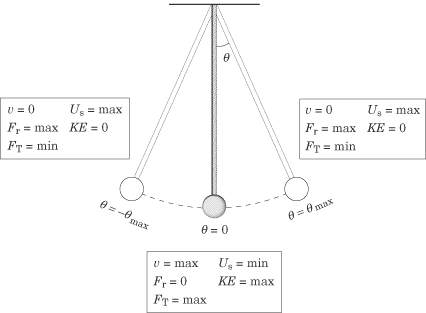Lesson: Chapter - 8
Pendulums
A pendulum is defined as a mass, or bob, connected to a rod or rope, that
experiences simple harmonic motion as it swings back and forth without friction.
The equilibrium position of the pendulum is the position when the mass is
hanging directly downward.
Consider a pendulum bob connected to a massless rope or rod that is held at an
angle
?max
from the horizontal. If you release the mass, then the system will swing to
position
-?max
and back again.

The oscillation of a pendulum is much like that of a mass on a spring. However,
there are significant differences, and many a student has been tripped up by
trying to apply the principles of a spring’s motion to pendulum motion.
Properties of Pendulum Motion
As with springs, there are a number of properties of pendulum motion that you
might be tested on, from frequency and period to kinetic and potential energy.
Let’s apply our three-step method of approaching special problems in mechanics
and then look at the formulas for some of those properties:
- Ask yourself how the system will move: It doesn’t take a rocket scientist
to surmise that when you release the pendulum bob it will accelerate toward the
equilibrium position. As it passes through the equilibrium position, it will
slow down until it reaches position
-?,
and then accelerate back. At any given moment, the velocity of the pendulum bob
will be perpendicular to the rope. The pendulum’s trajectory describes an arc of
a circle, where the rope is a radius of the circle and the bob’s velocity is a
line tangent to the circle.
- Choose a coordinate system: We want to calculate the forces acting on the
pendulum at any given point in its trajectory. It will be most convenient to
choose a y-axis that runs parallel to the rope. The x-axis then
runs parallel to the instantaneous velocity of the bob so that, at any given
moment, the bob is moving along the x-axis.
- Draw free-body diagrams: Two forces act on the bob: the force of gravity,
F =
mg, pulling the bob straight
downward and the tension of the rope,
FT,
pulling the bob upward along the y-axis. The gravitational force can be
broken down into an x-component, mg
sin?,
and a y-component, mg cos?.
The y component balances out the force of tension—the pendulum bob
doesn’t accelerate along the y-axis—so the tension in the rope must also
be mg cos?.
Therefore, the tension force is maximum for the equilibrium position and
decreases with
?.
The restoring force is mg sin
?,
so, as we might expect, the restoring force is greatest at the endpoints of the
oscillation,
? = ± ?max
and is zero when the pendulum passes through its equilibrium position.

You’ll notice that the restoring force for the pendulum,
mg sin?,
is not directly proportional to the displacement of the pendulum bob,
?,
which makes calculating the various properties of the pendulum very difficult.
Fortunately, pendulums usually only oscillate at small angles, where sin
? = ?.
In such cases, we can derive more straightforward formulas, which are admittedly
only approximations. However, they’re good enough for the purposes of subject test
Physics.
Period
The period of oscillation of the pendulum, T,
is defined in terms of the acceleration due to gravity,
g, and the length of the pendulum,
L:

This is a pretty scary-looking equation, but there’s really only one thing you
need to gather from it: the longer the pendulum rope, the longer it will take
for the pendulum to oscillate back and forth. You should also note that the mass
of the pendulum bob and the angle of displacement play no role in determining
the period of oscillation.
Energy
The mechanical energy of the pendulum is a conserved quantity. The potential
energy of the pendulum, mgh,
increases with the height of the bob; therefore the potential energy is
minimized at the equilibrium point and is maximized at
? = ± ?max.
Conversely, the kinetic energy and velocity of the pendulum are maximized at the
equilibrium point and minimized when
? = ± ?max.
The figure below summarizes this information in a qualitative manner, which is
the manner in which you are most likely to find it on subject test Physics. In this
figure, v signifies velocity,
F
signifies the restoring force,
FT
signifies the tension in the pendulum string, U signifies potential energy,
and KE signifies kinetic energy.

Velocity
Calculating the velocity of the pendulum bob at the equilibrium position requires
that we arrange our coordinate system so that the height of the bob at the equilibrium
position is zero. Then the total mechanical energy is equal to the kinetic energy at the
equilibrium point where U = 0. The total mechanical energy is also equal to the total
potential energy at ± ?max where KE = 0. Putting these equalities together, we get
E = 1/2mv2 = mgh
But what is h?

From the figure, we see that h = L - Lcos(-?max) . If we plug that value
into the equation above, we can solve for v:

Don’t let a big equation frighten you. Just register what it conveys: the longer
the string and the greater the angle, the faster the pendulum bob will move.
How This Knowledge Will Be Tested
Again, don’t worry too much about memorizing equations: most of the questions on
pendulum motion will be qualitative. There may be a question asking you at what
point the tension in the rope is greatest (at the equilibrium position) or where
the bob’s potential energy is maximized (at ? = ± ?max
).
It’s highly unlikely that you’ll be asked to give a specific number.
Back
Next
Next to display next topic in the chapter.
Practice Questions
Video Lessons and 10 Fully Explained Grand Tests
Large number of solved practice MCQ with explanations. Video Lessons and 10 Fully explained Grand/Full Tests.